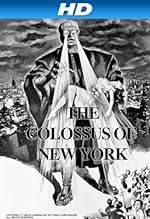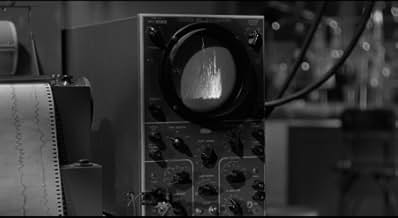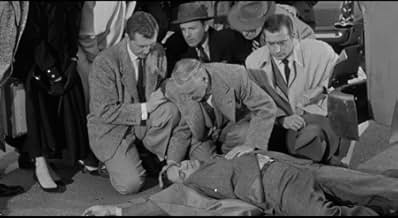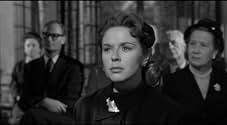ÉVALUATION IMDb
5,9/10
1,4 k
MA NOTE
Ajouter une intrigue dans votre langueA brilliant surgeon encases his dead son's brain in a large robot body, with unintended results...A brilliant surgeon encases his dead son's brain in a large robot body, with unintended results...A brilliant surgeon encases his dead son's brain in a large robot body, with unintended results...
George Douglas
- Official
- (uncredited)
Roy Engel
- Police Inspector
- (uncredited)
Sam Harris
- Man at Funeral Service
- (uncredited)
Larry Kerr
- Reporter
- (uncredited)
Harold Miller
- Airport Accident Extra
- (uncredited)
Dick Nelson
- Charles - Chauffeur-Butler
- (uncredited)
Foster H. Phinney
- Reporter
- (uncredited)
Jack Richardson
- Reporter
- (uncredited)
Court Shepard
- Reporter
- (uncredited)
Charles Sherlock
- Airline Pilot
- (uncredited)
Bert Stevens
- Airport Accident Extra
- (uncredited)
Avis en vedette
Paramount produced this fascinating, low-budget gem in 1958 and release it with a second feature which was tailor-made to go with it (see `The Space Children'). They played together at drive-in theaters nation wide, and thousand of kids like me watched them both in wide-eyed wonder.
Young viewers (15 to 25 years old) who watch either of these films today tend to totally miss the point. `The Colossus of New York' is an admirable and well-crafted exploration of concepts that were years ahead of their time: ideas like sensory deprivation, organ transplants, psychic powers, and others. This movie is NOT simply a Frankenstein rehash (as several misguided reviewers have claimed).
The story is about a noble, humanitarian genius whose brain is placed in an unfeeling robot body. The film invites the viewer to ponder what makes each of us the sensitive and compassionate person we are (or should be).
If `The Colossus of New York' seems hockey and corny to you, remember that it was designed for an audience -- and a culture -- that existed almost half a century ago. If you have the maturity and the intelligence to translate this message from a by-gone age, you'll benefit from your efforts.
If not . . . well, it's your loss.
Young viewers (15 to 25 years old) who watch either of these films today tend to totally miss the point. `The Colossus of New York' is an admirable and well-crafted exploration of concepts that were years ahead of their time: ideas like sensory deprivation, organ transplants, psychic powers, and others. This movie is NOT simply a Frankenstein rehash (as several misguided reviewers have claimed).
The story is about a noble, humanitarian genius whose brain is placed in an unfeeling robot body. The film invites the viewer to ponder what makes each of us the sensitive and compassionate person we are (or should be).
If `The Colossus of New York' seems hockey and corny to you, remember that it was designed for an audience -- and a culture -- that existed almost half a century ago. If you have the maturity and the intelligence to translate this message from a by-gone age, you'll benefit from your efforts.
If not . . . well, it's your loss.
Despite some clunky moments I still think the best and most eerie part of Colussus of new york is when the "dead" scientist awakes, and gradually with mounting terror, realises his brain is in the body of a robot! This scene I'm sure influenced Director Paul Verhoeven when he made "Robocop" many years later. look at the creepy visuals in this scene as we see everything from the robots P.O.V and note that its visualisation is similar to what you see on an old Television monitor. those lines spoken by his creator "you can see, you can hear, you can speak and you can move" still sends a chill down my spine. I rate this as one of the best eerie mad lab scenes in the movies.
"The Colossus of New York" has aged rather well. It still evokes the same strange fascination it had back in the late 1950s, when its story and title character startled me. It was evident back then that the film was a low-budget production, and that it was not a masterpiece of fantastic cinema, but its variation of the theme of the scientist that creates a monster was interesting, and the appearance of the colossus was impressive. I have read a couple of commentaries from producer William Alland, in which he expressed that he was very unsatisfied with the results, and put all the blame on Eugène Lourié. Allan definitely did not paid too much attention to the limitations of the budget he administered –forcing to reuse shots, and the inclusion of stock footage-, of Thelma Schnee's weak script, or the negligence of Floyd Knudtson's editing. But especially, Alland overlooked John F. Warren's images, some of which are remarkable. This is also due to Lourié's background: he was originally an art director and set designer, and it shows. The lightning, compositions and camera angles are effective most of the times, and compensate for the shortcomings. Where Lourié's lack of expertise shows is in the routine camera set-ups, putting the camera (and the spectator) in the same position, in scenes that take place in the same locations, but separate in time. This somehow makes the movie unfold too cautiously, an explanation to the speed up of some shots when the colossus moves. Otherwise it is a recommended, little cult film that will stick to your memory.
Although the title of this movie - "The Colossus of New York" - suggests that the Big Apple is terrorized for most of the running time, the title figure only goes on a (brief) rampage in the final few minutes. For just about the rest of the movie, the Colossus stays on a country estate near the city. Though it might have been more fun to show the Colossus on more of a rampage, the movie is still enjoyable. Certainly, there are some unintended chuckles, like the primitive science used to construct the Colossus. But there are actually some genuinely good moments here and there. The scene where the Colossus is first activated is both creepy and intriguing. And there are some pointed questions as to if the scientists are doing the right thing or not. Though the movie is cheap, there is some real atmosphere in part with the piano musical score, which gives this movie a really different feeling than other sci-fi movies of this period. Don't get me wrong - this isn't some intelligent masterpiece. But it manages to catch your attention, and at 70 minutes does not overstay its welcome.
Contrary to what some critics and viewers may say, THE COLOSSUS OF NEW YORK was actually quite dark and atmospheric! This was an exemplary modern-day take on the "Frankenstein's Monster" theme! The performances were well-done, the solo-piano music by Van Cleave was brilliant, and the Colossus itself was actually well created for its time. Even the climax, no matter how "cliched" by today's standard, is still poignant.
I definitely reccommend this movie! I think it deserves to be on DVD as well!
-John Cassidy
I definitely reccommend this movie! I think it deserves to be on DVD as well!
-John Cassidy
Le saviez-vous
- AnecdotesThe Colossus costume was eight feet tall, weighed 160 pounds and was made from burlap, plastic, rubber and fine chicken wire. Inside, there were batteries, cables, air tanks and oxygen tubes.
- GaffesWhen Jeremy (the Colossus) crashes through the glass wall at the end of the movie, the very next scene there is a woman lying on the floor and the man to the left of her looks down at her. In the scene following, the Colossus starts shooting eye beams. The eye beam then hits the woman, now standing, and she falls to the floor, in the same position.
- Générique farfeluThe opening credits text rises out of New York harbor, as its reflection on the water sinks to the bottom of the screen.
Meilleurs choix
Connectez-vous pour évaluer et surveiller les recommandations personnalisées
- How long is The Colossus of New York?Propulsé par Alexa
Détails
- Date de sortie
- Pays d’origine
- Langue
- Aussi connu sous le nom de
- Der Koloss von New York
- Lieux de tournage
- société de production
- Consultez plus de crédits d'entreprise sur IMDbPro
- Durée1 heure 10 minutes
- Couleur
- Rapport de forme
- 1.66 : 1
Contribuer à cette page
Suggérer une modification ou ajouter du contenu manquant

Lacune principale
By what name was The Colossus of New York (1958) officially released in Canada in English?
Répondre































